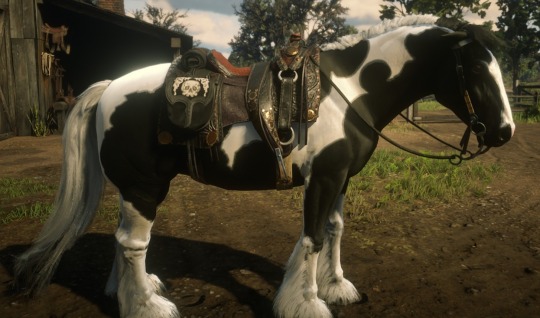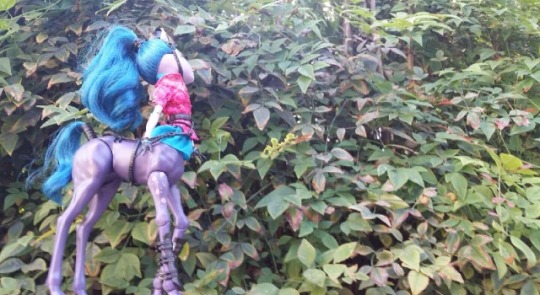#ava trotter
Text
Monster High Characters Sexuality Headcannons pt 3
Some of these were introduced in webisodes, and some in movies, like Freaky Fusion and Boo York, Boo York.
Amanita Nightshade-AroAce
Astranova- PolyPan
Ava Trotter-Bi
Batsy Claro-Aro
Bonita Femur-Pan
Catty Noir-Bi
Elle Eedee-Lesbian
Garrott du Roque-Straight
Gilda Goldstag-Bi
Invisi Billy-Gay
Isi Dawndancer-Pan
Jane Boolittle-Ace
Kjersti Trollson-Demi
Lorna McNessie-Straight
Luna Mothews-Lesbian
Marisol Coxi-Straight
Mouscedes King-Straight
Neighthan Rot-Gay
Seth Ptolemy-Bi
Sirena Von Boo-Lesbian
#monster high#headcannons#sexuality headcanons#gen 1#amanita nightshade#astranova#ava trotter#batsy claro#bonita femur#catty noir#elle eedee#garrott du roque#gilda goldstag#invisi billy#isi dawndancer#jane boolittle#kjersti trollson#lorna mcnessie#luna mothews#marisol coxi#mouscedes king#neighthan rot#seth ptolemy#sirena von boo#the only freaky fusion dolls i got were og the new charcters#whichh if u look at that line there are a lot since it can be broken down into 3#which the last doll i got when i stopped was of marisol#anyone else notice how they stopped giving new charcters pets?#like they will talk about them#but we dont get them
13 notes
·
View notes
Note
If you were to make like an MH reboot what would it be? Do you have any headcannons for Monster High?
Sorry for the absolute delay of this response but here it is !!!
Full and complete list, my Pinterest board is also on there.







I hope you ! If there are any additional questions, please ask, id love to talk about it, however ever after high is my true love so im not aaaas invested in MH as I am with EAH, so I'm not as caught up on everything.
#monster high ghoulia#monster high#monster high gen 1#monsterhigh g1#mh deuce#mh headcanons#monster high headcanons#mh heath#mh ghoulia#mh valentine#eah fanfic#mh venus#mh draculaura#mh clawdeen#mh cleo#mh clawd#mh cupid#mh nefera#mh rochelle#mh Robecca#robecca steam#mh howleen#mh toralei#mh twyla#mh pharoph#mh catty#mh jackson#mh holt#mh ava trotter#mh bonita
21 notes
·
View notes
Link
Ava Tortter by Mileymouse101
2 notes
·
View notes
Text
vimeo
the last landscape
millie walker as joanna
sam trotter as sue
directed by katie cox
written and edited by bonnie sanderson
produced by beth lindsay
cinematography by eva madgic govedarica
sound design by orla murray
production design by aimee combe and lucy smith
costumes by caitlin hutton
score by arina brovanova [@arina.music]
artwork by ava brimilcombe-cowie, peer theilen, katie cox and anna capocchi
special thanks to ben mcmorran, adam lockhart, mary hanna, parsley the cat and napier university
3 notes
·
View notes
Text
And my travelling companions. I named them all after favorite musicians 🤠

Freddie
The gray dapple Missouri Fox Trotter. Named after Freddie Mercury from Queen. My newest and most expensive purchase 😂

Hayley
The blood bay Thoroughbred, named after Hayley Williams from Paramore. My up and coming racehorse. Giving the "mare stare" in this photo 😂😂

Ava
The grullo dun Criollo, named after the band Angels and Airwaves, who often shorten their name to AVA. The OG racehorse and go to mount for anything that's long distance and requires speed. Also, the only one who doesn't throw me when she's spooked by predators or in an ambush. 😂😂

Lzzy
The black and white piebald Gypsy Cob, named after Lzzy Hale from Halestorm. My prettiest horse, and probably least used. I've been trying to use her more for collectors runs though. Has surprisingly good speed and stamina for her build tho.
#rdo#red dead horses#missouri fox trotter#thoroughbred#criollo#gypsy cob#horses#pretty girls#and pretty boy
13 notes
·
View notes
Photo

Name: Vampyressa Graywing
Nickname(s): Vampy
Age: 16
Gender: Female
Species: Humanoid bat monster
Birthday: April 12th
Pet: A gray-purple vampire bat named Dotty
BFFS: Batrina Graywing (sister) Myskia Graywing (sister)
Romantic Interest(s): Johnny Spirit (ex-boyfriend)
-
Name: Batrina Graywing
Nickname(s): Batty
Age: 16
Gender: Female
Species: Humanoid bat monster
Birthday: April 12th
Pet: A gray-purple vampire bat named Dotty
BFFS: Vampyressa Graywing (sister) Myskia Graywing (sister)
Romantic Interest(s): Kieran Valentine (ex? boyfriend? leave her alone...)
-
Name: Myskia Graywing
Nickname(s): Minnie
Age: 16
Gender: Female
Species: Humanoid bat monster
Birthday: April 12th
Pet: A gray-purple vampire bat named Dotty
BFFS: Vampyressa Graywing (sister) Batrina Graywing (sister)
Romantic Interest(s): Ava Trotter (ex-girlfriend) Bonita Femur (crush?)
#bleh oh god finally I've been working on them for so long#I thought of them like over a week ago I've been working on this picture for like three days I got distracted#and I've been sitting on posting this since this morning#I just got very distracted ugh I feel honestly pretty mad about it#here are the bat girls the bat triplets#yes they are identical besides the colored strip in their hair and their eyes#I'm honestly not sure what to do with them#they are bats not vampires I will stress not vampires are bats#monster high#fan characters#vampyressa graywing#batrina graywing#myskia graywing#edit: I fixed a good amount of this I skipped over without really thinking yesterday
1 note
·
View note
Photo

Brian Banks’ movie director Tom Shadyac Special Guest at Tuesday’s Private Screening Brian Banks Official Trailer https://youtu.be/k9-PqY5pEeo Tom Shadyac, Brian Banks movie director, and local actors Michelle Mitchell and Jeff Trotter will be special guests at the Colored Girls (Gale Jones Carson & TaJuan Stout Mitchell) private screening Tuesday, September 24, 2019. Supporting the NAACP Memphis Branch, this event begins at 6 p.m. and will be held at the Malco Paradiso, 584 S Mendenhall Rd, Memphis, TN. Memphis & Shelby County Film Commissioner Linn Sitler will also be a special guest. "Brian Banks" is a dramatization of the true story of its title character, who was headed to the University of Southern California and a likely pro football career before his life was derailed in 2002 by a false accusation of sexual assault and kidnapping. He was exonerated in 2012 after his case was accepted by attorney Justin Brooks (played in the film by Greg Kinnear) of the California Innocence Project, a San Diego-based nonprofit. According to Shadyac, director, screenwriter, producer, and author, Brian Banks is a protest against the criminal justice "conveyor belt," built to funnel people of color into prisons for the sake of law-enforcement convenience and industry profit, as examined in Ava DuVernay's documentary about mass incarceration, "The 13th." To purchase tickets click on this link: https://www.eventbrite.com/e/join-colored-girls-for-a-private-viewing-of-brian-banks-tickets-73058352499 OR NAACP Memphis Branch 588 Vance Ave, Memphis, TN 38126 901-521-1343 https://www.instagram.com/p/B2wPOCwl4rq/?igshid=1ezqtjk22emd4
0 notes
Text
20s Look
20s Look by sophie-boenel featuring a crystal light ❤ liked on Polyvore
Miu Miu long red dress, 4,895 BAM / Ava & Aiden high heel shoes, 125 BAM / Globe-Trotter Safari 20'' leather-trimmed fiberboard travel trolley, 2,650 BAM / Chanel pearl jewelry / Valentino white glove, 300 BAM / Home decor, 71 BAM / Frontgate crystal light, 5,170 BAM
0 notes
Text
Napa and Sonoma: Counties, Valleys, and Cities, Explained
There’s no question that Napa and Sonoma are two of the most beloved wine destinations in the world. What’s less certain, however, is what exactly people mean — or think they mean — when they talk about them.
Napa and Sonoma are both towns, counties, and valleys. As valleys, they are also often used interchangeably with their eponymous American Viticultural Areas (AVAs). And to make things more complicated, Napa and Sonoma’s overarching geographic areas are also home to many other wine country towns.
All of these variations — and their overlap — can be puzzling, to say the least. Consider the following a geography lesson to Northern California wine.
“People are often completely confused, and I have to explain the differences,” says Kellie Fuller, concierge for the Cottages of Napa Valley, who has worked in the wine and hospitality industry in Northern California for three decades. “And not everyone is staying at a place where there is a concierge.”
Indeed, visitors planning their own itineraries can be overwhelmed by the amount of information available online, from tourism websites to media coverage to forums on online booking sites. “On the TripAdvisor forums, I’m one of several self-appointed ambassadors to the Napa Valley,” Fuller says. “I’m always doing my best to answer questions and clear things up.”
Even Bay Area locals can get puzzled. Kelly Carter, communications director for Alpha Omega winery in Rutherford (in the heart of Napa Valley), and four-year resident of the Valley, recently received an email from a friend in San Francisco. The woman was requesting recommendations for wineries or tasting tours in Yountville, a charming town in Napa County; or Healdsburg, an equally popular town in Sonoma County. But Carter paused when she read it, because her friend said she “just [didn’t] want to go as far as Napa or Sonoma this time” — a head-scratching detail because both Yountville and Healdsburg are considerably farther, respectively, from San Francisco than the towns of Napa and Sonoma.
“People just don’t get it,” Carter says. “There’s Napa County, the city of Napa, and Napa Valley. People think they’re all just one big thing, and they’re not.”
Then, there’s the general confusion over geography, locals say. “People think Napa and Sonoma, as general wine regions, are five minutes apart, when in fact it can take you an hour or more” to travel between them, Carter says. She adds, “Oh, and by the way, there’s a mountain range that separates the two.”
Also, in difficult times when a fire breaks out in Northern California wine country, as is distressingly common in recent years, Fuller often receives calls from guests wondering if they should still come to the Cottages of Napa Valley, even if the fire is more than 50 miles away in Sonoma County.
The best way to make the most of any trip to the region is to do some homework ahead of time about how you want to explore it. “The experience is so important, so consider what kind you want to have,” says Jessica Boone, winemaker at Passalacqua, a popular winery in Sonoma County’s Dry Creek Valley. “Do you want to sit down for a seated tasting and have an hour or so to really get to know the wines, or do you want to hit several places that have bar tastings, where you can get more of a broad brushstroke of a place?”
To help answer those questions and clear up some confusion, we’ve put together a handy cheat sheet to explain these nuances. Think of it as a primer for planning your next trip, so that you can stop getting tripped up over county versus valley versus city — and start focusing on the fun stuff, like which winery you’ll hit first.
NAPA
Napa County
Napa County is home to nine cities and towns, from Napa itself (more on that below), to towns like Yountville, St. Helena, and Calistoga, located in the heart of the valley. Traveling from San Francisco, you’ll most likely come through the business corridor of American Canyon, which is about 10 miles south of the city of Napa. And with approximately 450 wineries with tasting rooms to choose from across the county, there is certainly something for all kinds of palates and drinkers, from the energetic newbie to the serious collector.
Napa Valley
This strip of land that runs up the middle of the county is what most people mean when they are talking about Napa’s winegrowing region. In 1981, Napa Valley became the first AVA, or American Viticultural Area, designated in California, and there are currently 16 sub-appellations within it. Napa Valley’s geographic footprint is relatively small — just 30 miles long and five miles across at its widest point, about a third of the size of the entire county — but the region produces some of the world’s most coveted wines. Varieties like Cabernet Sauvignon and Chardonnay are virtually synonymous with Napa Valley, but winemakers here also produce Pinot Noir, Merlot, Zinfandel, and Sauvignon Blanc, among others.
There are two main roads that run north-south in Napa Valley: Highway 29, the beautiful but heavily trafficked two-lane road that goes through its most prominent wine-centric towns, like Napa, Yountville, St. Helena, and then Calistoga; and the Silverado Trail, known in locals’ parlance just as “the Trail,” which runs east of Highway 29 and is flanked by such wineries as Stag’s Leap Wine Cellars and Robert Phelps. Several smaller through-ways connect Highway 29 and the Silverado Trail. Near Calistoga, at the northern end of the Silverado Trail, wine and movie buffs will delight in a stop at Chateau Montelena, which put California in the global spotlight in the 1976 Judgement of Paris (Stag’s Leap also won that day).
You’ll probably also hear residents saying “up valley” or “down valley,” and you may notice those terms in names of local businesses, too. They’re used interchangeably as both a geographic location (“I live up valley” — as in Calistoga, for example) or direction (“I’m headed down valley for an appointment this afternoon”).
The City of Napa
Over the last decade, the city of Napa has evolved from a quick stopover for thirsty visitors on their way to wineries up valley (around Yountville and Calistoga, that is), to a destination in its own right. The completion of extensive flood-control measures and a multi-million-dollar renovation along the riverfront and downtown have brought unprecedented energy and droves of travelers as of late. Tasting rooms intertwine with buzzing restaurants and boutiques, and even if you’re just passing through, a stop at the excellent Oxbow Public Market to stock up on gourmet picnic provisions is a must-do.
One especially noteworthy newer addition to the dining scene is Compline, a restaurant and wine shop founded by Master Sommelier Matt Stamp and Ryan Stetins, who oversaw the programs at Charlie Trotter in Chicago and Las Vegas. Meanwhile, a handful of snazzy new hotels, including the Andaz Napa and the Archer Hotel Napa, make downtown Napa an ideal home base for exploring Northern California wine country.
SONOMA
Sonoma County
More spread out than its Napa counterpart, Sonoma County stretches from about 30 miles north of San Francisco all the way up to the small town of Cloverdale, just off Highway 101. More than 30 cities and towns are dotted throughout its 1,768 square miles, most of which are entrenched in the wine industry, spanning about 425 wineries with tasting rooms. Healdsburg is a hub for tasting-centric getaways, while funky Guerneville, on the Russian River, is more laid back.
Go further west, and you’ll hit the coast — in fact, many first-time visitors don’t realize that Sonoma County borders the Pacific Ocean, and its 55 miles of rugged coastline are the secret ingredient to some of its most coveted Pinot Noirs and Chardonnays.
Sonoma Valley
You won’t hear people throwing around the term Sonoma Valley, one of 18 AVAs in Sonoma County, as often as they do Napa Valley. But it has the longest history of any wine-growing region in Sonoma County, dating to the 1850s. Located in the southeast corner of the county, Sonoma Valley is best known for its robust Zinfandel, whose gnarled vines look like troll hands clawing their way from the soil. Lately, varieties like Malbec, Syrah, and Grenache are also gaining traction.
The City of Sonoma
Nestled in the heart of Sonoma Valley, the city of Sonoma itself is a delightful place to spend a day. Many of its tasting rooms are centered around the leafy town square; most welcome walk-ins, but call ahead for reservations on busy weekends. Pinot lovers shouldn’t miss stopping in Sojourn, known for its outstanding Pinot Noir. When it’s time for a bite, Girl & the Fig is a 20-year-old wine country institution that helped put farm-to-table fare on the map.
The article Napa and Sonoma: Counties, Valleys, and Cities, Explained appeared first on VinePair.
source https://vinepair.com/articles/napa-vs-sonoma-travel-guide/
0 notes
Text
Napa and Sonoma: Counties Valleys and Cities Explained
There’s no question that Napa and Sonoma are two of the most beloved wine destinations in the world. What’s less certain, however, is what exactly people mean — or think they mean — when they talk about them.
Napa and Sonoma are both towns, counties, and valleys. As valleys, they are also often used interchangeably with their eponymous American Viticultural Areas (AVAs). And to make things more complicated, Napa and Sonoma’s overarching geographic areas are also home to many other wine country towns.
All of these variations — and their overlap — can be puzzling, to say the least. Consider the following a geography lesson to Northern California wine.
“People are often completely confused, and I have to explain the differences,” says Kellie Fuller, concierge for the Cottages of Napa Valley, who has worked in the wine and hospitality industry in Northern California for three decades. “And not everyone is staying at a place where there is a concierge.”
Indeed, visitors planning their own itineraries can be overwhelmed by the amount of information available online, from tourism websites to media coverage to forums on online booking sites. “On the TripAdvisor forums, I’m one of several self-appointed ambassadors to the Napa Valley,” Fuller says. “I’m always doing my best to answer questions and clear things up.”
Even Bay Area locals can get puzzled. Kelly Carter, communications director for Alpha Omega winery in Rutherford (in the heart of Napa Valley), and four-year resident of the Valley, recently received an email from a friend in San Francisco. The woman was requesting recommendations for wineries or tasting tours in Yountville, a charming town in Napa County; or Healdsburg, an equally popular town in Sonoma County. But Carter paused when she read it, because her friend said she “just [didn’t] want to go as far as Napa or Sonoma this time” — a head-scratching detail because both Yountville and Healdsburg are considerably farther, respectively, from San Francisco than the towns of Napa and Sonoma.
“People just don’t get it,” Carter says. “There’s Napa County, the city of Napa, and Napa Valley. People think they’re all just one big thing, and they’re not.”
Then, there’s the general confusion over geography, locals say. “People think Napa and Sonoma, as general wine regions, are five minutes apart, when in fact it can take you an hour or more” to travel between them, Carter says. She adds, “Oh, and by the way, there’s a mountain range that separates the two.”
Also, in difficult times when a fire breaks out in Northern California wine country, as is distressingly common in recent years, Fuller often receives calls from guests wondering if they should still come to the Cottages of Napa Valley, even if the fire is more than 50 miles away in Sonoma County.
The best way to make the most of any trip to the region is to do some homework ahead of time about how you want to explore it. “The experience is so important, so consider what kind you want to have,” says Jessica Boone, winemaker at Passalacqua, a popular winery in Sonoma County’s Dry Creek Valley. “Do you want to sit down for a seated tasting and have an hour or so to really get to know the wines, or do you want to hit several places that have bar tastings, where you can get more of a broad brushstroke of a place?”
To help answer those questions and clear up some confusion, we’ve put together a handy cheat sheet to explain these nuances. Think of it as a primer for planning your next trip, so that you can stop getting tripped up over county versus valley versus city — and start focusing on the fun stuff, like which winery you’ll hit first.
NAPA
Napa County
Napa County is home to nine cities and towns, from Napa itself (more on that below), to towns like Yountville, St. Helena, and Calistoga, located in the heart of the valley. Traveling from San Francisco, you’ll most likely come through the business corridor of American Canyon, which is about 10 miles south of the city of Napa. And with approximately 450 wineries with tasting rooms to choose from across the county, there is certainly something for all kinds of palates and drinkers, from the energetic newbie to the serious collector.
Napa Valley
This strip of land that runs up the middle of the county is what most people mean when they are talking about Napa’s winegrowing region. In 1981, Napa Valley became the first AVA, or American Viticultural Area, designated in California, and there are currently 16 sub-appellations within it. Napa Valley’s geographic footprint is relatively small — just 30 miles long and five miles across at its widest point, about a third of the size of the entire county — but the region produces some of the world’s most coveted wines. Varieties like Cabernet Sauvignon and Chardonnay are virtually synonymous with Napa Valley, but winemakers here also produce Pinot Noir, Merlot, Zinfandel, and Sauvignon Blanc, among others.
There are two main roads that run north-south in Napa Valley: Highway 29, the beautiful but heavily trafficked two-lane road that goes through its most prominent wine-centric towns, like Napa, Yountville, St. Helena, and then Calistoga; and the Silverado Trail, known in locals’ parlance just as “the Trail,” which runs east of Highway 29 and is flanked by such wineries as Stag’s Leap Wine Cellars and Robert Phelps. Several smaller through-ways connect Highway 29 and the Silverado Trail. Near Calistoga, at the northern end of the Silverado Trail, wine and movie buffs will delight in a stop at Chateau Montelena, which put California in the global spotlight in the 1976 Judgement of Paris (Stag’s Leap also won that day).
You’ll probably also hear residents saying “up valley” or “down valley,” and you may notice those terms in names of local businesses, too. They’re used interchangeably as both a geographic location (“I live up valley” — as in Calistoga, for example) or direction (“I’m headed down valley for an appointment this afternoon”).
The City of Napa
Over the last decade, the city of Napa has evolved from a quick stopover for thirsty visitors on their way to wineries up valley (around Yountville and Calistoga, that is), to a destination in its own right. The completion of extensive flood-control measures and a multi-million-dollar renovation along the riverfront and downtown have brought unprecedented energy and droves of travelers as of late. Tasting rooms intertwine with buzzing restaurants and boutiques, and even if you’re just passing through, a stop at the excellent Oxbow Public Market to stock up on gourmet picnic provisions is a must-do.
One especially noteworthy newer addition to the dining scene is Compline, a restaurant and wine shop founded by Master Sommelier Matt Stamp and Ryan Stetins, who oversaw the programs at Charlie Trotter in Chicago and Las Vegas. Meanwhile, a handful of snazzy new hotels, including the Andaz Napa and the Archer Hotel Napa, make downtown Napa an ideal home base for exploring Northern California wine country.
SONOMA
Sonoma County
More spread out than its Napa counterpart, Sonoma County stretches from about 30 miles north of San Francisco all the way up to the small town of Cloverdale, just off Highway 101. More than 30 cities and towns are dotted throughout its 1,768 square miles, most of which are entrenched in the wine industry, spanning about 425 wineries with tasting rooms. Healdsburg is a hub for tasting-centric getaways, while funky Guerneville, on the Russian River, is more laid back.
Go further west, and you’ll hit the coast — in fact, many first-time visitors don’t realize that Sonoma County borders the Pacific Ocean, and its 55 miles of rugged coastline are the secret ingredient to some of its most coveted Pinot Noirs and Chardonnays.
Sonoma Valley
You won’t hear people throwing around the term Sonoma Valley, one of 18 AVAs in Sonoma County, as often as they do Napa Valley. But it has the longest history of any wine-growing region in Sonoma County, dating to the 1850s. Located in the southeast corner of the county, Sonoma Valley is best known for its robust Zinfandel, whose gnarled vines look like troll hands clawing their way from the soil. Lately, varieties like Malbec, Syrah, and Grenache are also gaining traction.
The City of Sonoma
Nestled in the heart of Sonoma Valley, the city of Sonoma itself is a delightful place to spend a day. Many of its tasting rooms are centered around the leafy town square; most welcome walk-ins, but call ahead for reservations on busy weekends. Pinot lovers shouldn’t miss stopping in Sojourn, known for its outstanding Pinot Noir. When it’s time for a bite, Girl & the Fig is a 20-year-old wine country institution that helped put farm-to-table fare on the map.
The article Napa and Sonoma: Counties, Valleys, and Cities, Explained appeared first on VinePair.
Via https://vinepair.com/articles/napa-vs-sonoma-travel-guide/
source https://vinology1.weebly.com/blog/napa-and-sonoma-counties-valleys-and-cities-explained
0 notes
Text
Napa and Sonoma: Counties, Valleys, and Cities, Explained
There’s no question that Napa and Sonoma are two of the most beloved wine destinations in the world. What’s less certain, however, is what exactly people mean — or think they mean — when they talk about them.
Napa and Sonoma are both towns, counties, and valleys. As valleys, they are also often used interchangeably with their eponymous American Viticultural Areas (AVAs). And to make things more complicated, Napa and Sonoma’s overarching geographic areas are also home to many other wine country towns.
All of these variations — and their overlap — can be puzzling, to say the least. Consider the following a geography lesson to Northern California wine.
“People are often completely confused, and I have to explain the differences,” says Kellie Fuller, concierge for the Cottages of Napa Valley, who has worked in the wine and hospitality industry in Northern California for three decades. “And not everyone is staying at a place where there is a concierge.”
Indeed, visitors planning their own itineraries can be overwhelmed by the amount of information available online, from tourism websites to media coverage to forums on online booking sites. “On the TripAdvisor forums, I’m one of several self-appointed ambassadors to the Napa Valley,” Fuller says. “I’m always doing my best to answer questions and clear things up.”
Even Bay Area locals can get puzzled. Kelly Carter, communications director for Alpha Omega winery in Rutherford (in the heart of Napa Valley), and four-year resident of the Valley, recently received an email from a friend in San Francisco. The woman was requesting recommendations for wineries or tasting tours in Yountville, a charming town in Napa County; or Healdsburg, an equally popular town in Sonoma County. But Carter paused when she read it, because her friend said she “just [didn’t] want to go as far as Napa or Sonoma this time” — a head-scratching detail because both Yountville and Healdsburg are considerably farther, respectively, from San Francisco than the towns of Napa and Sonoma.
“People just don’t get it,” Carter says. “There’s Napa County, the city of Napa, and Napa Valley. People think they’re all just one big thing, and they’re not.”
Then, there’s the general confusion over geography, locals say. “People think Napa and Sonoma, as general wine regions, are five minutes apart, when in fact it can take you an hour or more” to travel between them, Carter says. She adds, “Oh, and by the way, there’s a mountain range that separates the two.”
Also, in difficult times when a fire breaks out in Northern California wine country, as is distressingly common in recent years, Fuller often receives calls from guests wondering if they should still come to the Cottages of Napa Valley, even if the fire is more than 50 miles away in Sonoma County.
The best way to make the most of any trip to the region is to do some homework ahead of time about how you want to explore it. “The experience is so important, so consider what kind you want to have,” says Jessica Boone, winemaker at Passalacqua, a popular winery in Sonoma County’s Dry Creek Valley. “Do you want to sit down for a seated tasting and have an hour or so to really get to know the wines, or do you want to hit several places that have bar tastings, where you can get more of a broad brushstroke of a place?”
To help answer those questions and clear up some confusion, we’ve put together a handy cheat sheet to explain these nuances. Think of it as a primer for planning your next trip, so that you can stop getting tripped up over county versus valley versus city — and start focusing on the fun stuff, like which winery you’ll hit first.
NAPA
Napa County
Napa County is home to nine cities and towns, from Napa itself (more on that below), to towns like Yountville, St. Helena, and Calistoga, located in the heart of the valley. Traveling from San Francisco, you’ll most likely come through the business corridor of American Canyon, which is about 10 miles south of the city of Napa. And with approximately 450 wineries with tasting rooms to choose from across the county, there is certainly something for all kinds of palates and drinkers, from the energetic newbie to the serious collector.
Napa Valley
This strip of land that runs up the middle of the county is what most people mean when they are talking about Napa’s winegrowing region. In 1981, Napa Valley became the first AVA, or American Viticultural Area, designated in California, and there are currently 16 sub-appellations within it. Napa Valley’s geographic footprint is relatively small — just 30 miles long and five miles across at its widest point, about a third of the size of the entire county — but the region produces some of the world’s most coveted wines. Varieties like Cabernet Sauvignon and Chardonnay are virtually synonymous with Napa Valley, but winemakers here also produce Pinot Noir, Merlot, Zinfandel, and Sauvignon Blanc, among others.
There are two main roads that run north-south in Napa Valley: Highway 29, the beautiful but heavily trafficked two-lane road that goes through its most prominent wine-centric towns, like Napa, Yountville, St. Helena, and then Calistoga; and the Silverado Trail, known in locals’ parlance just as “the Trail,” which runs east of Highway 29 and is flanked by such wineries as Stag’s Leap Wine Cellars and Robert Phelps. Several smaller through-ways connect Highway 29 and the Silverado Trail. Near Calistoga, at the northern end of the Silverado Trail, wine and movie buffs will delight in a stop at Chateau Montelena, which put California in the global spotlight in the 1976 Judgement of Paris (Stag’s Leap also won that day).
You’ll probably also hear residents saying “up valley” or “down valley,” and you may notice those terms in names of local businesses, too. They’re used interchangeably as both a geographic location (“I live up valley” — as in Calistoga, for example) or direction (“I’m headed down valley for an appointment this afternoon”).
The City of Napa
Over the last decade, the city of Napa has evolved from a quick stopover for thirsty visitors on their way to wineries up valley (around Yountville and Calistoga, that is), to a destination in its own right. The completion of extensive flood-control measures and a multi-million-dollar renovation along the riverfront and downtown have brought unprecedented energy and droves of travelers as of late. Tasting rooms intertwine with buzzing restaurants and boutiques, and even if you’re just passing through, a stop at the excellent Oxbow Public Market to stock up on gourmet picnic provisions is a must-do.
One especially noteworthy newer addition to the dining scene is Compline, a restaurant and wine shop founded by Master Sommelier Matt Stamp and Ryan Stetins, who oversaw the programs at Charlie Trotter in Chicago and Las Vegas. Meanwhile, a handful of snazzy new hotels, including the Andaz Napa and the Archer Hotel Napa, make downtown Napa an ideal home base for exploring Northern California wine country.
SONOMA
Sonoma County
More spread out than its Napa counterpart, Sonoma County stretches from about 30 miles north of San Francisco all the way up to the small town of Cloverdale, just off Highway 101. More than 30 cities and towns are dotted throughout its 1,768 square miles, most of which are entrenched in the wine industry, spanning about 425 wineries with tasting rooms. Healdsburg is a hub for tasting-centric getaways, while funky Guerneville, on the Russian River, is more laid back.
Go further west, and you’ll hit the coast — in fact, many first-time visitors don’t realize that Sonoma County borders the Pacific Ocean, and its 55 miles of rugged coastline are the secret ingredient to some of its most coveted Pinot Noirs and Chardonnays.
Sonoma Valley
You won’t hear people throwing around the term Sonoma Valley, one of 18 AVAs in Sonoma County, as often as they do Napa Valley. But it has the longest history of any wine-growing region in Sonoma County, dating to the 1850s. Located in the southeast corner of the county, Sonoma Valley is best known for its robust Zinfandel, whose gnarled vines look like troll hands clawing their way from the soil. Lately, varieties like Malbec, Syrah, and Grenache are also gaining traction.
The City of Sonoma
Nestled in the heart of Sonoma Valley, the city of Sonoma itself is a delightful place to spend a day. Many of its tasting rooms are centered around the leafy town square; most welcome walk-ins, but call ahead for reservations on busy weekends. Pinot lovers shouldn’t miss stopping in Sojourn, known for its outstanding Pinot Noir. When it’s time for a bite, Girl & the Fig is a 20-year-old wine country institution that helped put farm-to-table fare on the map.
The article Napa and Sonoma: Counties, Valleys, and Cities, Explained appeared first on VinePair.
source https://vinepair.com/articles/napa-vs-sonoma-travel-guide/
source https://vinology1.tumblr.com/post/189809082974
0 notes
Photo


Ava exploring some new stomping grounds with Jane
12 notes
·
View notes